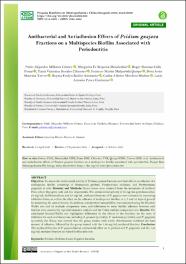| dc.contributor.author | Millones Gómez, Pablo Alejandro | es_ES |
| dc.contributor.author | Requena Mendizábal, Margarita Fe | es_ES |
| dc.contributor.author | Calla Poma, Roger Damaso | es_ES |
| dc.contributor.author | Rosales Cifuentes, Tania Valentina | es_ES |
| dc.contributor.author | Malpartida Quispe, Federico Martin | es_ES |
| dc.contributor.author | Maurtua Torres, Dora Jesús | es_ES |
| dc.contributor.author | Bacilio Amaranto, Reyma Evelyn | es_ES |
| dc.contributor.author | Minchón Medina, Carlos Alberto | es_ES |
| dc.contributor.author | Ponce Contreras, Lusin Antonio | es_ES |
| dc.date.accessioned | 2022-10-25T15:41:14Z | |
| dc.date.available | 2022-10-25T15:41:14Z | |
| dc.date.issued | 2022 | |
| dc.identifier.uri | https://hdl.handle.net/20.500.13053/6926 | |
| dc.description.abstract | Objective: To assess the antibacterial activity of Psidium guajava fractions and their effects on adhesion of a multispecies biofilm consisting of Streptococcus gordonii, Fusobacterium nucleatum, and Porphyromonas gingivalis in vitro. Material and Methods: Guava leaves were obtained from the mountains of northern Peru, where they grow wild and free of pesticides. The antimicrobial activity of 25 mg/mL petroleum ether, 25 mg/mL dichloromethane and 25 mg/mL methanol fractions of P. guajava was evaluated by measuring inhibition halos, as well as the effect on the adhesion of multispecies biofilms at 4, 7 and 10 days of growth by measuring the optical density. In addition, antimicrobial susceptibility was compared using the Kruskal-Wallis test and its multiple comparison tests, and differences in mean biofilm adhesion between each fraction were assessed by repeated measures analysis and the Tukey multiple comparison test. Results: The rank-based Kruskal-Wallis test highlighted differences in the effects of the fractions on the zone of inhibition for each oral bacterium, including S. gordonii(p=0.000), F. nucleatum (p=0.000), and P. gingivalis (p=0.000), the Tukey test showed that the group treated with 0.12% chlorhexidine exhibited the least amount of adhesion, followed by the group treated with the 1.56 mg/mL methanol fraction. Conclusion: The methanol fraction of P. guajava had an antibacterial effect on S. gordonii and P. gingivalis, and the 1.56 mg/mL methanol fraction decreased biofilm adhesion. | es_ES |
| dc.format | application/pdf | es_ES |
| dc.language.iso | eng | es_ES |
| dc.publisher | Association of Support to Oral Health Research (APESB) | es_ES |
| dc.rights | info:eu-repo/semantics/openAccess | es_ES |
| dc.rights.uri | https://creativecommons.org/licenses/by/4.0/ | es_ES |
| dc.subject | Psidium, Biofilms, Gram-Negative Bacteria | es_ES |
| dc.title | Antibacterial and Antiadhesion Effects of Psidium guajava Fractions on a Multispecies Biofilm Associated with Periodontitis | es_ES |
| dc.type | info:eu-repo/semantics/article | es_ES |
| dc.identifier.doi | https://doi.org/10.1590/pboci.2022.028ISSN 1519-0501 / eISSN 1983-4632 | es_ES |
| dc.type.version | info:eu-repo/semantics/publishedVersion | es_ES |
| dc.publisher.country | BR | es_ES |
| dc.subject.ocde | http://purl.org/pe-repo/ocde/ford#3.03.00 | es_ES |


